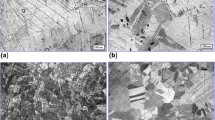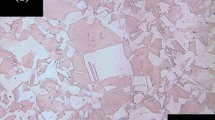Abstract
Cu and Cu–Al alloys with different stacking fault energies (SFEs) were processed using rolling and the Split Hopkinson pressure bar followed by rolling. The effect of strain rate on the microstructures and mechanical properties of the alloys were investigated using x-ray diffraction analyses, transmission electron microscopy, and tensile tests. Tensile testing results demonstrated that the strength and ductility of the samples increased simultaneously with decreasing SFE. Microstructural observations indicated that the average grain size of the samples decreased with decreasing SFE, but the twin and dislocation densities increased. With decreasing SFE, twinning becomes the dominant deformation mechanism. Our findings indicated that the SFEs significantly affect the strength and ductility of the materials because they play a key role in determining the deformation mechanism. Decreasing the SFE of Cu alloys has proved to be the optimum method to improve the ductility without compromising the strength of the material.






Similar content being viewed by others
References
H. Li, J.Q. Zhou, R.T. Zhu, and X. Ling: The evolution of porosity in bulk nanocrystalline materials during plastic deformation and its effect on the mechanical behavior. Mater. Des. 31, 1003 (2010).
R.Z. Valiev and T.G. Langdon: Principles of equal-channel angular pressing as a processing tool for grain refinement. Prog. Mater. Sci. 51, 881 (2006).
C.C. Koch: Synthesis of nanostructured materials by mechanical milling: Problems and opportunities. Nanostruct. Mater. 9, 13 (1997).
Y. Saito, H. Utsunomiya, N. Tsuji, and T. Sakai: Novel ultra-high straining process for bulk materials—development of the accumulative roll-bonding (ARB) process. Acta Mater. 47, 579 (1999).
A.P. Zhilyaev and T.G. Langdon: Using high-pressure torsion for metal processing: Fundamentals and applications. Prog. Mater. Sci. 53, 893 (2008).
Y.Z. Tian, X.H. An, S.D. Wu, Z.F. Zhang, R.B. Figueiredo, N. Gao, and T.G. Langdon: Direct observations of microstructural evolution in a two-phase Cu–Ag alloy processed by high-pressure torsion. Scr. Mater. 63, 65 (2010).
Y.Z. Tian, W.Z. Han, H.J. Yang, S.X. Li, S.D. Wu, and Z.F. Zhang: Shear banding observations in Cu–16 wt% Ag alloy subjected to one-pass equal channel angular pressing. Scr. Mater. 62, 183 (2010).
Z.F. Zhang, S.D. Wu, Y.J. Li, S.M. Liu, and Z.G. Wang: Cyclic deformation and fatigue properties of Al–0.7 wt% Cu alloy produced by equal channel angular pressing. Mater. Sci. Eng., A 412, 279 (2005).
C.X. Huang, K. Wang, S.D. Wu, Z.F. Zhang, G.Y. Li, and S.X. Li: Deformation twinning in polycrystalline copper at room temperature and low strain rate. Acta Mater. 54, 655 (2006).
K. Han, R.P. Walsh, A. Ishmaku, V. Toplosky, L. Brandao, and J.D. Embury: High strength and high electrical conductivity bulk Cu. Philos. Mag. 84, 3705 (2004).
D.A. Hughes and N. Hansen: Microstructure and strength of nickel at large strains. Acta Mater. 48, 2985 (2000).
F.D. Torre, R. Lapovok, J. Sandlin, P.F. Thomson, and C.H.J. Davies: Microstructures and properties of copper processed by equal channel angular extrusion for 1–16 passes. Acta Mater. 52, 4819 (2004).
O.V. Mishin and G. Gottstein: Microstructural aspects of rolling deformation in ultrafine-grained copper. Philos. Mag. A 78, 373 (1998).
C.C. Koch: Optimization of strength and ductility in nanocrystalline and ultrafine grained metals. Scr. Mater. 49, 657 (2003).
Y.H. Zhao, X.Z. Liao, Z. Horita, T.G. Langdon, and Y.T. Zhu: Determining the optimal stacking fault energy for achieving high ductility in ultrafine-grained Cu–Zn alloys. Mater. Sci. Eng., A 493, 123 (2008).
X.H. An, W.Z. Han, C.X. Huang, P. Zhang, G. Yang, S.D. Wu, and Z.F. Zhang: High strength and utilizable ductility of bulk ultrafine-grained Cu–Al alloys. Appl. Phys. Lett. 92, 201915 (2008).
H. Bahmanpour, A. Kauffmann, M.S. Khoshkhoo, K.M. Youssef, S. Mula, J. Freudenberger, J. Eckert, R.O. Scattergood, and C.C. Koch: Effect of stacking fault energy on deformation behavior of cryo-rolled copper and copper alloys. Mater. Sci. Eng., A 529, 230 (2011).
Y.S. Li, Y. Zhang, N.R. Tao, and K. Lu: Effect of the Zener–Hollomon parameter on the microstructures and mechanical properties of Cu subjected to plastic deformation. Acta Mater. 57, 761 (2009).
F. Huang and N.R. Tao: Effects of strain rate and deformation temperature on microstructures and hardness in plastically deformed pure aluminum. J. Mater. Sci. Technol. 27, 1 (2011).
C.C. Koch, D.G. Morris, K. Lu, and A. Inoue: Ductility of nanostructured materials. Mater. Res. Soc. Bull. 24, 54 (1999).
L.E. Murr: Interfacial Phenomena in Metals and Alloys (Addison-Wesley Publishing Co., New York, NY, 1975), pp. 87–164.
B.S. Murty, T. Venugopal, and K.P. Rao: Mechanical and electrical properties of Cu-Ta nanocomposites prepared by high-energy ball milling. Acta Metall. 55, 4439 (2007).
R.E. Smallman and K.H. Westmacott: Stacking faults in face-centred cubic metals and alloys. Philos. Mag. 2, 669 (1957).
G.K. Williamson and R.E. Smallman: Dislocation densities in some annealed and cold-worked metals from measurements on the x-ray Debye-Scherrer spectrum. Philos. Mag. 1, 34 (1956).
J.B. Cohen and C.N.J. Wagner: Determination of twin fault probabilities from the diffraction patterns of fcc metals and alloys. J. Appl. Phys. 33, 2073 (1962).
C.N.J. Wagner: Stacking faults by low-temperature cold work in copper and alpha brass. Acta Metall. 5, 427 (1957).
N. Hansen: Hall–Petch relation and boundary strengthening. Scr. Mater. 51, 801 (2004).
X.X. Huang: Tailoring dislocation structures and mechanical properties of nanostructured metals produced by plastic deformation. Scr. Mater. 60, 1078 (2009).
R. Labusch: A statistical theory of solid solution hardening. Phys. Status Solidi 41, 659 (1970).
O. Vöhringer: The influence of alloy type and concentration on the yield point of alpha-copper alloys. Z. Metallkde. 65, 352 (1974).
R.L. Fleischer: Substitutional solution hardening. Acta Metall. 11, 203 (1963).
S. Nagarjuna, M. Srinivas, and K.K. Sharma: The grain size dependence of flow stress in a Cu–26Ni–17Zn alloy. Acta Mater. 48, 1807 (2000).
E.O. Hall: The deformation and ageing of mild steel: III Discussion of results. Proc. Phys. Soc. B 64, 747 (1951).
N.J. Petch: The cleavage strength of poly-crystals. J. Iron Steel Inst., London 174, 25 (1953).
K. Lu, L. Lu, and S. Suresh: Strengthening materials by engineering coherent internal boundaries at the nanoscale. Science 324, 349 (2009).
Y.F. Shen, L. Lu, Q.H. Lu, Z.H. Jin, and K. Lu: Tensile properties of copper with nano-scale twins. Scr. Mater. 52, 989 (2005).
W.J. Babyak and F.N. Rhines: The relationship between the boundary area and hardness of recrystallized cartridge brass. Trans. Metall. Soc. AIME 218, 21 (1960).
Y. Zhang, N.R. Tao, and K. Lu: Effects of stacking fault energy, strain rate and temperature on microstructure and strength of nanostructured Cu–Al alloys subjected to plastic deformation. Acta Mater. 59, 6048 (2011).
T.D. Shen and C.C. Koch: Formation, solid solution hardening and softening of nanocrystalline solid solutions prepared by mechanical attrition. Acta Mater. 44, 753 (1996).
Y.H. Zhao, Z. Horita, T.G. Langdon, and Y.T. Zhu: Evolution of defect structures during cold rolling of ultrafine-grained Cu and Cu–Zn alloys: Influence of stacking fault energy. Mater. Sci. Eng., A 474, 342 (2008).
J. Gubicza, N.Q. Chinh, J.L. Lábár, Z. Hegedus, and T.G. Langdon: Principles of self-annealing in silver processed by equal-channel angular pressing: The significance of a very low stacking fault energy. Mater. Sci. Eng., A 527, 752 (2010).
L. Lu, Y. Shen, X. Chen, L. Qian, and K. Lu: Ultrahigh strength and high electrical conductivity in copper. Science 304, 422 (2004).
Y.H. Zhao, J.F. Bingert, X.Z. Liao, B.Z. Cui, K. Han, A. V. Sergueeva, A.K. Mukherjee, R.Z. Valiev, T.G. Langdon, and Y.T. Zhu: Simultaneously increasing the ductility and strength of ultra-fine-grained pure copper. Adv. Mater. 18, 2949 (2006).
J.W. Christian and S. Mahajan: Deformation twinning. Prog. Mater. Sci. 39, 1 (1995).
A. Rohatgi, K.S. Vecchio, and G.T. Gray, III: A metallographic and quantitative analysis of the influence of stacking fault energy on shock-hardening in Cu and Cu–Al alloys. Acta Mater. 49, 427 (2001).
C. Zener and J.H. Hollomon: Effect of strain rate upon plastic flow of steel. J. Appl. Phys. 15, 22 (1944).
G.H. Xiao, N.R. Tao, and K. Lu: Effects of strain, strain rate and temperature on deformation twinning in a Cu–Zn alloy. Scr. Mater. 59, 975 (2008).
Y.S. Li, Y. Zhang, N.R. Tao, and K. Lu: Effect of thermal annealing on mechanical properties of a nanostructured copper prepared by means of dynamic plastic deformation. Scr. Mater. 59, 475 (2008).
U.F. Kocks, A.S. Argon, and M.F. Ashby: Thermodynamics and kinetics of slip. Prog. Mater. Sci. 19, 26 (1975).
K. Wang, N.R. Tao, G. Liu, J. Lu, and K. Lu: Plastic strain-induced grain refinement at the nanometer scale in copper. Acta Mater. 54, 5281 (2006).
N. Hansen: Cold deformation microstructures. Mater. Sci. Technol. 6, 1039 (1990).
ACKNOWLEDGMENTS
The authors are greatly grateful to the National Natural Science Foundation of China (NSFC), Grant Nos. 50874056 and 51361017, and the Australian Research Council (ARC) through the ARC Discovery Project DP110101974 to CW for supporting this research.
Author information
Authors and Affiliations
Corresponding author
Rights and permissions
About this article
Cite this article
Cai, B., Long, Y., Wen, C. et al. Role of stacking fault energy and strain rate in strengthening of Cu and Cu–Al alloys. Journal of Materials Research 29, 1747–1754 (2014). https://doi.org/10.1557/jmr.2014.210
Received:
Accepted:
Published:
Issue Date:
DOI: https://doi.org/10.1557/jmr.2014.210




